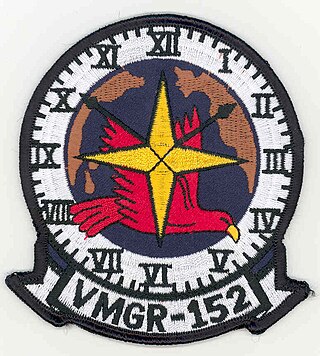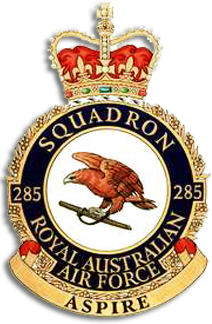
The Nineteenth Air Force is an active Numbered Air Force of the United States Air Force. During the Cold War it was a component of Tactical Air Command, with a mission of command and control over deployed USAF forces in support of United States foreign policy initiatives. The command was reactivated in 1993 under Air Education and Training Command with a mission of conducting AETC's flying training.

The Lockheed HC-130 is an extended-range, search and rescue (SAR)/combat search and rescue (CSAR) version of the C-130 Hercules military transport aircraft, with two different versions operated by two separate services in the U.S. armed forces.

The 53rd Weather Reconnaissance Squadron, also known by its nickname, Hurricane Hunters, is a flying unit of the United States Air Force, and "the only Department of Defense organization still flying into tropical storms and hurricanes." Aligned under the 403rd Wing of the Air Force Reserve Command (AFRC) and based at Keesler Air Force Base, Mississippi, with ten aircraft, it flies into tropical cyclones in the Atlantic Ocean, the Caribbean Sea, the Gulf of Mexico and the Central Pacific Ocean for the specific purpose of directly measuring weather data in and around those storms. The 53rd WRS currently operates the Lockheed WC-130J aircraft as its weather data collection platform.

A loadmaster is an aircrew member on military transport aircraft or civilian aircraft tasked with the safe loading, transport and unloading of aerial cargoes. Loadmasters serve in the militaries and civilian airlines of many nations.

Little Rock Air Force Base is a United States Air Force base located approximately 17 miles (27 km) northeast of Little Rock, Arkansas.

Altus Air Force Base is a United States Air Force base located approximately 4 miles (6.4 km) east-northeast of Altus, Oklahoma.

Marine Aerial Refueler Transport Squadron 152 (VMGR-152) provides aerial refueling service to support Fleet Marine Force (FMF) air operations; and provides assault air transport of personnel, equipment, and supplies. The squadron, known as the "Sumos", flies the fixed-wing Lockheed Martin KC-130J aircraft. VMGR-152 is stationed at Marine Corps Air Station Iwakuni, Iwakuni, Japan and is part of Marine Aircraft Group 12 (MAG-12) and the 1st Marine Aircraft Wing.

Marine Heavy Helicopter Squadron 464 (HMH-464) is a United States Marine Corps helicopter squadron consisting of CH-53E Super Stallion transport helicopters. The squadron is known as the "Condors" and is based at Marine Corps Air Station New River, North Carolina. They fall under the command of Marine Aircraft Group 29 (MAG-29) and the 2nd Marine Aircraft Wing.

Marine Aerial Refueler Transport Squadron 352 (VMGR-352) is a United States Marine Corps KC-130J squadron. They are a part of Marine Aircraft Group 11 (MAG-11), 3rd Marine Aircraft Wing and provide both fixed-wing and rotary-wing aerial refueling capabilities to support Fleet Marine Force (FMF) air operations in addition to assault air transport of personnel, equipment, and supplies. The squadron, known as the "Raiders" is stationed at Marine Corps Air Station Miramar, California.

Marine Aerial Refueler Transport Squadron 452 (VMGR-452) was a reserve United States Marine Corps cargo squadron that previously flew the Lockheed Martin KC-130J. The squadron fell under the command of Marine Aircraft Group 49 (MAG-49) and the 4th Marine Aircraft Wing. The squadron, known as the "Yankees", was stationed at Stewart Air National Guard Base, New York.

Marine Aerial Refueler Transport Squadron 252 (VMGR-252) is a United States Marine Corps KC-130J squadron. They are a part of Marine Aircraft Group 14 (MAG-14), 2nd Marine Aircraft Wing and provide both fixed-wing and rotary-wing aerial refueling capabilities to support Fleet Marine Force air operations in addition to assault air transport of personnel, equipment, and supplies. The squadron, known as "Otis" is stationed at Marine Corps Air Station Cherry Point, North Carolina. It also has the distinction of being the oldest continually active squadron in the Marine Corps.

No. 285 Squadron was a Royal Australian Air Force (RAAF) training squadron. Controlled by No. 84 Wing, the squadron was formed in August 1999 to train the RAAF's Lockheed Martin C-130J Hercules aircrew and ground support staff. No. 285 Squadron did not control any flying aircraft but managed the flight simulator used for converting aircrew to the C-130Js operated by No. 37 Squadron. It was also allocated decommissioned Hercules airframes for training purposes, as well as flying aircraft from No. 37 Squadron when required. Throughout its existence, No. 285 Squadron was located at RAAF Base Richmond in the western suburbs of Sydney. The squadron was disbanded in December 2017.

Marine Fighter Attack Training Squadron 101 (VMFAT-101) was a United States Marine Corps F/A-18 Hornet training squadron. The squadron was last based at Marine Corps Air Station Miramar, California and fell under the command of Marine Aircraft Group 11 (MAG-11) and the 3rd Marine Aircraft Wing.

Marine Heavy Helicopter Training Squadron 302 (HMHT-302), is a United States Marine Corps helicopter training squadron stationed at Marine Corps Air Station New River, North Carolina. Known as the "Phoenix", HMHT-302 trains newly designated Naval Aviators, conversion pilots, refresher pilots, and enlisted aircrew on the CH-53E Super Stallion and falls under the command of Marine Aircraft Group 29 (MAG-29) and the 2nd Marine Aircraft Wing.

Marine Medium Tiltrotor Training Squadron 204 (VMMT-204) is the MV-22 Osprey training squadron of the United States Marine Corps. Known as the "Raptors", the squadron was originally designated Marine Medium Helicopter Training Squadron 204 (HMT-204) to train new MV-22 pilots and was officially redesignated as VMMT-204 on 10 June 1999. They fall under the command of Marine Aircraft Group 26 (MAG-26) and the 2nd Marine Aircraft Wing.

The 507th Air Refueling Wing is a reserve component flying unit of the United States Air Force. It is assigned to Fourth Air Force of Air Force Reserve Command, stationed at Tinker Air Force Base, Oklahoma with elements at Altus Air Force Base, Oklahoma. The 507th ARW executes air refueling, airlift, and training in support of Air Mobility Command and U.S. Strategic Command's national emergency war order requirements. The wing employs approximately 1,100 men and women made up of a mix of Traditional Reservists, full-time Air Reserve Technicians, AGRs and Air Force civilians. The wing also provides mission support for all other reserve units stationed at Tinker AFB.

The United States Marine Corps Aviation (USMCA) is the aircraft arm of the United States Marine Corps. Aviation units within the Marine Corps are assigned to support the Marine Air-Ground Task Force, as the aviation combat element, by providing six functions: assault support, antiair warfare, close air support, electronic warfare, control of aircraft and missiles, and aerial reconnaissance. The Corps operates rotary-wing, tiltrotor, and fixed-wing aircraft mainly to provide transport and close air support to its ground forces. Other aircraft types are also used in a variety of support and special-purpose roles. All Marine Corps aviation falls under the influence of the Deputy Commandant for Aviation, whose job is to advise the Commandant of the Marine Corps in all matters relating to aviation, especially acquisition of new assets, conversions of current aircraft, maintenance, operation, and command.

The 189th Airlift Wing is a unit of the Arkansas Air National Guard, stationed at Little Rock Air Force Base, Arkansas. If activated to federal service, it is gained by the United States Air Force Air Education and Training Command.

The Lockheed MartinKC-130 is a family of the extended-range tanker version of the C-130 Hercules transport aircraft. The KC-130J is the latest variant operated by the United States Marine Corps (USMC), with 48 delivered out of 79 ordered. It replaced older KC-130F, KC-130R, and KC-130T variants for aerial refueling. USMC reserve unit, VMGR-452 operated 12 KC-130T aircraft until May 2021; this was the last USMC reserve unit that operated the legacy KC-130s, completing the corps' transition to the more advanced Super Hercules.

Fleet Logistics Support Squadron 62 (VR-62), nicknamed the Nomads, is one of five U.S. Navy Reserve squadrons operating the Lockheed C-130T Hercules medium-lift cargo aircraft. Based at Naval Air Station Jacksonville, Florida, the squadron is manned by a combination of traditional part-time drilling Selected Reservists (SELRES) and a full-time active duty Navy Reserve cadre known as Training and Administration of the Reserve (TAR) personnel (previously known as Full Time Support (FTS) personnel from August 2006 to November 2021). The squadron is under the operational control of Commander, Fleet Logistics Support Wing(COMFLELOGSUPWING) at NAS JRB Fort Worth, Texas.























